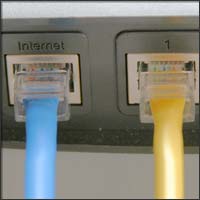 By: Billy BeerSlugger
By: Billy BeerSlugger
First of all, I’d like to thank you for allowing me to steal your internet this whole time. I just feel kind of guilty now that I’ve downloaded all the porn on the internet using your signal that I thought I’d tell you how to put a password on your wireless network so that someone else doesn’t do the same thing to you.
Seriously though, if you have a Wireless Internet connection and it’s not protected by a password you may be opening yourself up to a host of security problems not to mention other people stealing your bandwidth so you can’t download your own porn as fast as you could be. You definitely don’t want to be liable when the weird dude down the hall from you grabs some kiddie porn using your Wireless Network. Everyone knows you don’t download kiddie porn on your own internet service, you go to your buddies house or you steal an internet signal from the stupid person with the unsecured network in your apartment building.
So I’ll assume that you can actually access the internet from your Wireless Router but never had to put a password in to connect to it (If you have secured your wireless network you can probably skip the rest of this article).
Here’s what you can do to try and set the password but before I tell you I want you to know that I’m not liable if you fuck something up.
- Using a network cable you should temporarily connect your computer to one of the open network ports on your wireless router (any port that isn’t labeled Internet, WAN, or WLAN). If you need to, turn your computer on. It should automatically connect to your router.
- Next, open Internet Explorer and type in the address to configure your router.
- You might be prompted for a password. The address and password you use will vary depending on what type of router you have, so refer to the instructions included with your router.
- As a quick reference, this table shows the default addresses, usernames, and passwords for some common router manufacturers.
| Router | Address | Username | Password |
| 3Com | http://192.168.1.1 | admin | admin |
| D-Link | http://192.168.0.1 | admin | |
| Linksys | http://192.168.1.1 | admin | admin |
| Microsoft Broadband | http://192.168.2.1 | admin | admin |
| Netgear | http://192.168.0.1 | admin | password |
Internet Explorer will show your router’s configuration page. Most of the default settings should be fine, but you should configure three things:
- Your wireless network name, known as the SSID. This name identifies your network. You should choose something unique that none of your neighbors will be using.
- Wireless encryption (WEP) or Wi-Fi Protected Access (WPA), which help protect your wireless network. For most routers, you will provide a passphrase that your router uses to generate several keys. Make sure your passphrase is unique and long (you don’t need to memorize it).
- Your administrative password, which controls your wireless network. Just like any other password, it should not be a word that you can find in the dictionary, and it should be a combination of letters, numbers, and symbols. Be sure you can remember this password, because you’ll need it if you ever have to change your router’s settings.
- The exact steps you follow to configure these settings will vary depending on the type of router you have. After each configuration setting, be sure to click Save Settings, Apply, or OK to save your changes.
That should be it. You should now be able to connect to your wireless network using a password and thus thwarting the efforts of would be child pornography downloaders.
